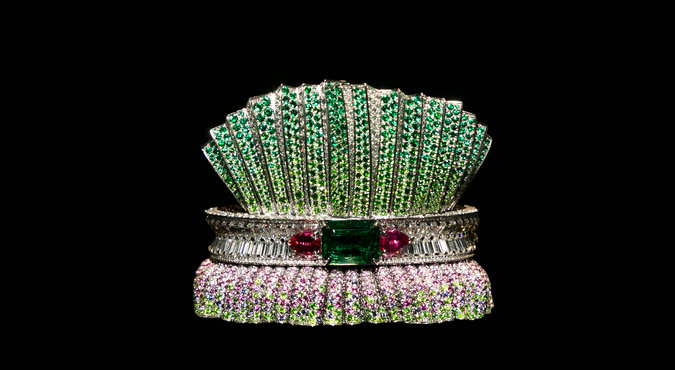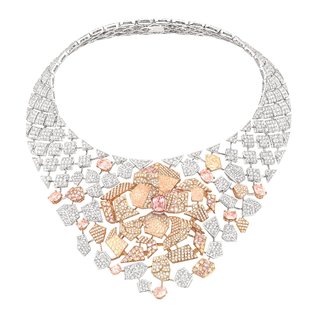
White Gold Jewelry
White gold is an alloy comprising gold and at least one white metal. This alloy is then plated with a hard element called ‘rhodium’, which may wear off with time. The jewelry can be plated again to restore its white sheen. White gold jewelry or utensils may comprise varying amounts of pure gold in it. White gold is often considered an alternative to yellow gold, silver or platinum, because of its comparatively lower price. Some metals commonly used to make white gold include platinum, nickel, palladium & manganese. The properties of this alloy, besides its color, depend on its chemical make-up, or composition. Also, without the rhodium coating, ‘white gold’ may appear pale pink or dull brown in color.
Owing to its malleability, it is easy to create varying, wonderful designs with white gold; thus a favorite with jewelers. It has a brighter polish than platinum which itself has a slightly grayish hue.
Origin & History
The history of White Gold dates back to 1710, when it was composed by alchemists Johan Frierich Bottger and Ehrenfried Walther Von Tcshirnhaus in Germany. In 1752, another metal resembling White Gold was introduced, with a grey finish. White Gold as we know today was created in 1920’s.
There are two variations to the history of white gold. One says that it was patented by the Belais brothers in 1920 made by combining gold, nickel and zinc. The brothers had begun experimenting with white gold formulas to substitute platinum. They held the patent till sometime in the 1930’s.
The other supposition states that white gold was made from the fusion of gold and nickel with palladium in 1915, by Karl Richter, a German chemist. It is said that after World War II, some countries started stockpiling platinum because of its durability to make batteries, cells and other necessary parts for military use. Due to the deficiency of platinum, jewelers decided to promote the mixture of nickel, palladium or zinc to pure gold to bleach its yellow hue and turn it into white gold.
The Making
Obtaining white gold involves mixing gold with other metals to bleach the yellow tint of gold. White gold is almost never available in 24 karat gold, as gold has to be mixed with pure gold.
Variety
White gold is available in 14 carats, 18 carats or 21 carats depending on the kind of jewelry being made. High-carat white gold alloys are far more resistant to corrosion than pure silver or sterling silver. Fourteen and eighteen-carat gold alloys with silver appear greenish-yellow and are referred to as green gold. There are different formulas today for making white gold whiter and brighter. It may be 75% of Gold containing 17.3% Nickel, 5.5% Zinc and 2.2% Copper is silvery in appearance. Another combination is 75% Gold, 15% Silver and 10% Titanium.
Post 1930’s several companies began announcing white gold as a part of their collections. In 1930, Aquamarine and Diamond necklaces were introduced which were of 54.70 carat in weight. These were also made in 14 carat. Thereafter men’s wrist watches were presented in white gold having long lasting calendars on them.
Rhodium plated White Gold is a good option as it provides a barrier between the skin and nickel alloy. The other advantage is that it makes the white gold look whiter. This plating wears out in three years, to reveal the original white gold beneath and the process can be repeated.
Besides, white gold is available in green color which is created by fusing gold and silver and excluding copper. Cadmium is mixed to vary the green tint and a higher percentage of cadmium gets a darker green shade. Black gold is created by the process of electroplating black rhodium or ruthenium on gold. Another method creates a controlled oxidation of the gold using chromium and cobalt.
Present Day Scenario
Water resistant white gold wrist watches were launched in the 21st century, in adjustable sizes for men and women. Weighing 18 carats and of a fine quality, these were made with a combination of metals such as silver, platinum and tin and had a grey finish. White gold is a favorite with brides not only for engagement and wedding rings but for all kinds of jewelry in fancy settings. The market for men’s jewelry has grown with men’s diamond rings becoming all the rage. Heavy bands with a squared-off look combined with emeralds or cat’s eye are in great demand.
Innovations
Palladium-based white gold is expensive and nickel based ones can cause allergy, so the use of magnesium as a whitener in making the white gold is catching up. This new alloy is palladium-free or has a low content of palladium. Some white gold jewelry also contains chromium or iron, which are used as whiteners but it causes the product to be hard. These alloys are rhodium plated anyway to enhance whiteness.
Accessorizing
White gold can be worn with outfits in light colors of Beige, White or could be boldly suffused with the color of black! Team it up with Ethnic as well as western outfits.
Suitability
Some people, if allergic to nickel, should avoid wearing white gold jewelry if nickel is one of the metals in the composition.
Maintenance
White Gold is easier to repair, fix, reset, solder, polish and straighten. White Gold should be stored separate from other jewelry and polished with a soft cloth. Cleaning products are available in the market that includes sprays and wipes.


